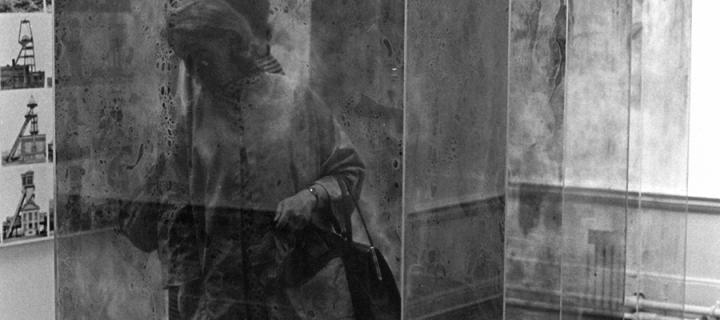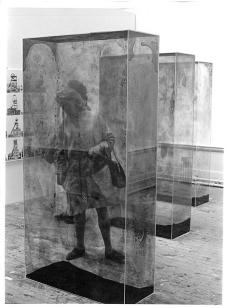19. The art critic Cordelia Oliver among glass containers by Erich Reusch and photographs by Bernd and Hilla Becher in studio E.25
The curatorial juxtaposition of Reusch’s transparent coal-dust containers with the Bechers’ photographs of ‘Pitheads’ was a comment on the industrial revolution.

Erich Reusch (1925-2019) studied at the Hochschule für Bildende Künste in Berlin from 1947 to 1953.
He conceived of his first minimalist floor sculptures, dispensing with a pedestal, in the early 1950s, years ahead of Carl Andre and Richard Serra. He was interested in the potential of sculpture to redefine space to create a specific and unmistakeable ‘location’ rather than focusing on sculptural form in itself.
Reusch became known for his electrostatic objects of containers made from Plexiglas and containing soot, objects which were exhibited at Strategy: Get Arts. These created a visible but inaccessible interior space. The boxes were a translucent presence, and due to the electrostatic charge the work was in a constant process of transformation, with a dynamic flow of soot being deposited in tracks on the glass surfaces.
Reusch and Bechers

At SGA, the Reusch boxes were appropriately displayed next to photographs of pitheads by Bernd and Hilla Becher.
The Bechers first met at the Kunstakademie Düsseldorf in 1957 and collaborated on documenting the industrial architecture of the Ruhr valley in 1959. They drew inspiration from earlier German photographers associated with New Objectivity, especially August Sander, who was particularly important to them for his taxonomical mode of presentation.
The Bechers sent two versions of their typological grids of pitheads (which they referred to as ‘Anonymous Sculptures’) to Edinburgh for Strategy: Get Arts.
The juxtaposition of Reusch’s transparent containers with the Bechers’ worker-less frame structures was well curated. The dispersal of ‘coal dust’ in the electrostatic boxes could be seen as an abstract visualisation of a mine shaft, or at a bodily level, the deadly circulation of mine dust in the respiratory system. This exhibition space was possibly a comment on the industrial revolution, or perhaps its decline, with the impending collapse of local economies and close-knit mining communities.
The Bechers made their first visit to England in 1965, then spent six months touring England, Wales, and Scotland in 1966 on a grant from the British Council, and took hundreds of photographs of the coal industry around
- the Rhondda Valley,
- Sheffield,
- Liverpool,
- Manchester,
- and Nottingham.
Many of the photographs of pitheads, which were often used in different grid groupings, were therefore taken at British collieries. It could be that SGA represented the first time that the Bechers’ work had been seen in Britain.
Later, they were to become internationally acclaimed, a significant influence on
- Andreas Gursky,
- Candida Höfer,
- Axel Hütte,
- Simone Nieweg,
- Thomas Ruff,
- Laurenz Berges ,
- Thomas Struth,
- and Petra Wunderlich,
among many others.
C.W.


